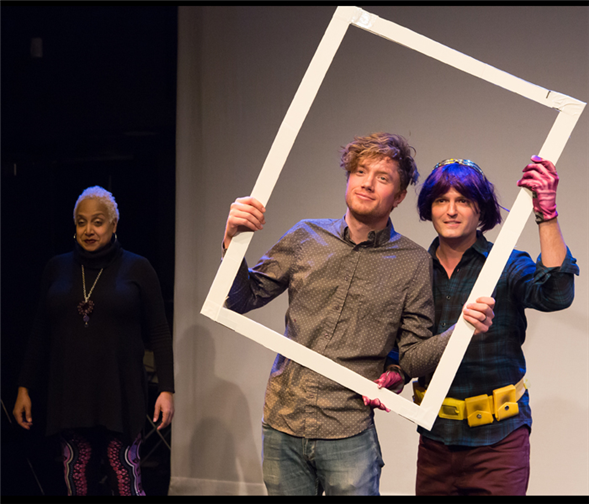Translate Page

Inside 'The Great American Drama'
---
The New York Neo-Futurists really want your feedback on their latest show. Even if you don't see it, you can fill out a survey telling them what you prefer to see on stage, and they'll incorporate your ideas into their production. And if you do end up in the audience, you'll have several opportunities to deliver a review. Then they'll incorporate those comments into the production as well.
That means The Great American Drama, which is now running at A.R.T./New York Theatres through February 5, may be the year's most crowdsourced play. Every moment – every scene, every song, every whimsical anecdote or painful personal memory – is in some way a response to a suggestion.
"When I describe this show to people, I say it's the story of four people on a treadmill trying to please everyone," says Connor Sampson, a New York Neo-Futurists company member who is credited here as a performer, creator, co-writer, and co-director. "We are trying to listen to the voice of the people."
The four performers make it clear that patrons feed the machine. In one section, for instance, we see a projected image of a survey response (complete with the date it was received) that asks for great works from the playwrights Henrik Ibsen, Eugene O'Neill, William Inge, and Tennessee Williams. And so, just like that, an actor picks up a script and starts reading scenes from those writers' plays. Then we see projections asking for things like "good acting" and "really good acting" and even "great acting", and as each one pops up, the performer tries to comply.
This can be hilarious, particularly when the actors honor contradictory input. Should there be lots of tears? No tears? Lots of music? No music? How about all of the above?!?
But this show is more than an excuse for hijinks. Its form is intended to capture something essential about being American.
{Image1}
"The conceit originates from the American Dream, the idea that if you work hard enough and you're determined enough, you'll be successful," says Sampson.
In this case success means making the audience happy and earning enough money to stay afloat. So as we watch the performers incorporate suggestions – while also discussing how much they've earned during the run – we're watching them in the act of "being American." We're watching them strive.
Plus, as they fulfill our requests, the performers display a little of that can-do American ingenuity. Take the section where they deal with the demands for on-stage nudity: As they slowly disrobe, some of the cast members tell their true stories of sexual abuse. Their exposed flesh not only satisfies our prurience, but also forces us to remember that the bodies we might objectify belong to human beings. Crucially, too, audience members are given the power to end the scene at any point, just by saying "stop." This requires us to decide how much exploitation we're willing to accept.
"We've signed up to play by the rules of the American Dream, but in doing that, we can still share our voices and our craft," Sampson says. "We give the audience what they want, but maybe in ways they didn't expect. It's boring to get what you want, how you wanted it. It's interesting to get what you want in a surprising way."
---
TDF Members: At press time, discount tickets were available for 'The Great American Drama.' Go here to browse our latest offers.
Follow TDF Stages editor Mark Blankenship at @IAmBlankenship. Follow TDF at @TDFNYC.
Photos by Hunter Canning. Top photo (L to r): Nicole Hill, Connor Sampson, and Daniel McCoy.